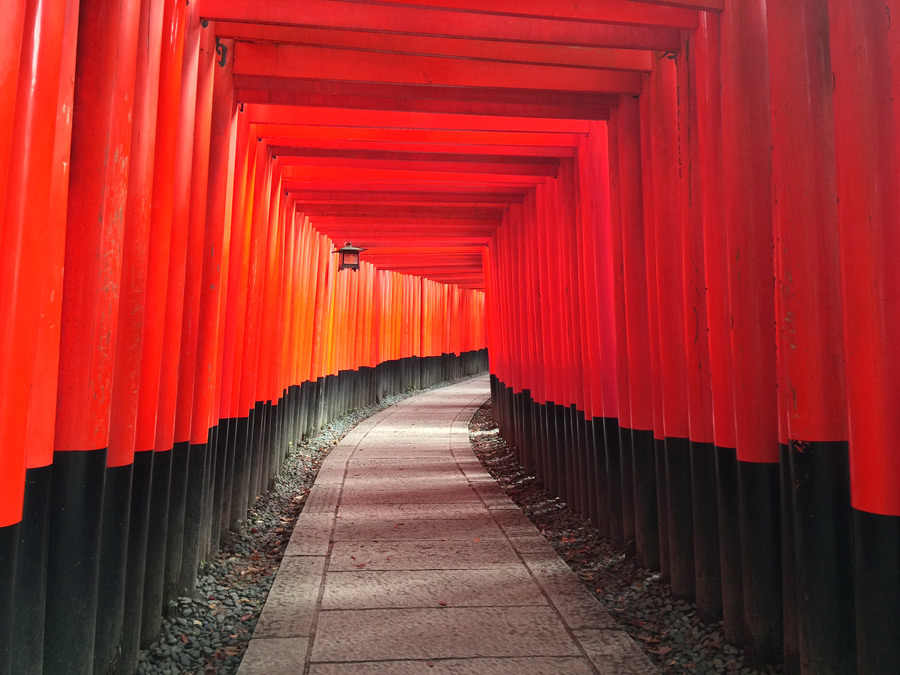
Fushimi Inari-taisha
Journey through thousands of vermilion gates to the heart of prosperity.
Kyoto's iconic head shrine of Inari, the kami of rice and business, famed for its mesmerizing network of thousands of vermilion torii gates that snake up a sacred mountain.
History of the Shrine
Founded in 711 AD, Fushimi Inari-taisha holds the distinction of being the head shrine for the approximately 30,000 Inari shrines scattered across Japan. Its origins are intertwined with the powerful Hata clan, who dedicated the shrine to Inari Okami, the kami of rice, sake, and prosperity. The shrine gained immense popularity during the Edo period as a patron deity for merchants and manufacturers, solidifying its association with success and financial fortune.
The most defining feature, the thousands of vermilion torii gates, began as a tradition of patronage. Individuals and businesses seeking success or expressing gratitude for fortunes received would donate a gate. This centuries-long practice has created the breathtaking 'Senbon Torii' (Thousand Torii) paths, a seemingly endless tunnel of vibrant red that forms a sacred pilgrimage route up the 233-meter Mount Inari. This journey is not just a physical climb but a symbolic passage from the mundane world into a divine, mystical space.
The Enshrined Kami
Inari Okami is one of Japan's most popular and widely worshipped deities, a benevolent kami associated with a vast portfolio of blessings including rice, sake, tea, agriculture, industry, merchants, and general prosperity. Inari is often depicted as androgynous, sometimes as a young female food goddess, other times as an old man carrying rice, or as a bodhisattva.
This ambiguity allows for broad interpretation and worship. Inari's most prominent symbol is the fox, or 'kitsune', which acts as a divine messenger. This has led to the common misconception that Inari is a fox god, but the kitsune are revered servants, not the deity itself. Their presence reinforces the shrine's mystical atmosphere and its connection to nature and divine communication.
What to See
The main attraction is undeniably the 'Senbon Torii'. The journey starts behind the main hall with two dense, parallel rows of gates that create an otherworldly experience. As you ascend Mount Inari, the path splits and the gates become less dense, interspersed with smaller sub-shrines, stone altars ('otsuka'), and charming tea houses offering rest and refreshment.
Pay close attention to the hundreds of fox statues ('kitsune') found throughout the grounds. Foxes are considered the divine messengers of Inari, and these statues are often depicted holding symbolic items in their mouths, such as a key to the rice granary, a jewel representing the kami's spirit, or a scroll of wisdom. Another key sight is the Romon Gate at the shrine's entrance, donated in 1589 by the great leader Toyotomi Hideyoshi. The main shrine hall, or 'Honden', is an Important Cultural Property, showcasing a classic style of shrine architecture.
Major Festivals
The most important festival is 'Hatsu-uma Taisai' in early February, celebrating the legendary founding of the shrine in 711 on the first day of the horse in the second month. The 'Sanka-sai' festival on the nearest Sunday to April 8th features large, decorative floats. However, the most visually stunning event is the 'Motomiya-sai' in July, where thousands of lanterns are lit all over the mountain, and the donated torii are illuminated, creating a magical, dreamlike atmosphere that attracts worshippers and photographers alike.
Support Fushimi Inari-taisha
Your participation helps preserve this sacred site for future generations. Every digital offering contributes to real shrine preservation efforts across Japan.
By making an offering, you become part of a global community honoring Japanese spiritual traditions and supporting the cultural heritage that has been cherished for centuries.